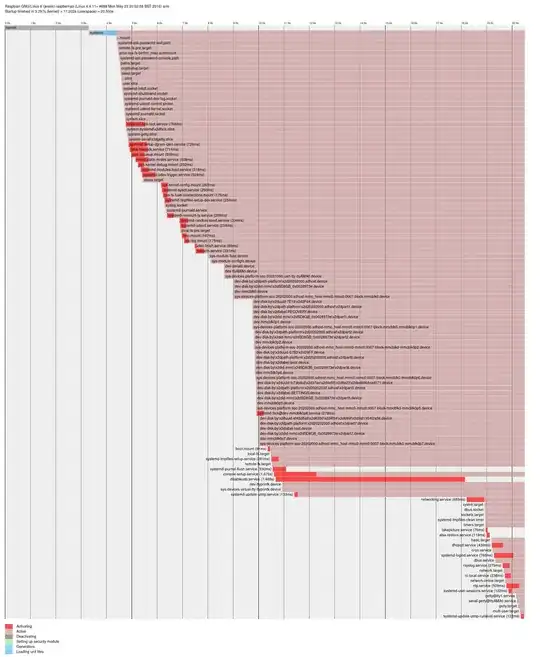After removing most of the services that I don't need, it still takes about 28 seconds to boot, take a picture and shut down.
I would like to lower this even more, and I did a systemd-analyze blame and got the following:
7.476s disableusb.service
1.736s keyboard-setup.service
958ms kbd.service
789ms systemd-fsck-root.service
737ms systemd-setup-dgram-qlen.service
722ms fake-hwclock.service
580ms kmod-static-nodes.service
565ms console-setup.service
534ms dev-mqueue.mount
518ms systemd-udev-trigger.service
498ms networking.service
489ms raspi-config.service
449ms hdparm.service
444ms systemd-journal-flush.service
376ms systemd-tmpfiles-setup.service
375ms dhcpcd.service
345ms systemd-logind.service
332ms ntp.service
317ms systemd-modules-load.service
281ms tmp.mount
272ms triggerhappy.service
269ms sys-kernel-debug.mount
265ms systemd-fsck@dev-mmcblk0p6.service
223ms rsyslog.service
221ms sys-kernel-config.mount
212ms systemd-tmpfiles-setup-dev.service
200ms systemd-remount-fs.service
198ms systemd-sysctl.service
184ms boot.mount
173ms systemd-random-seed.service
168ms rc-local.service
167ms user@1000.service
165ms var-log.mount
141ms udev-finish.service
130ms sys-fs-fuse-connections.mount
111ms systemd-user-sessions.service
94ms systemd-update-utmp.service
94ms alsa-restore.service
93ms systemd-update-utmp-runlevel.service
77ms systemd-udevd.service
55ms takepicture.service
disableusb.service is mine, and unlike what the name implies it does other things as well. I doubt I can improve the time there.
My system is running headless, by serial. I only need networking via wifi (wifi doesn't start because I disable the usb power, but sometimes I won't disable it, so that it can start).
Looking at this list, I see things such as: 1.736s keyboard-setup.service and 958ms kbd.service. They take almost 3 seconds. Do I need them if I am not using a keyboard? If not, how do I disable them?
What else can I safely disable from here?
Ok, there is something really strange going here. I disabled some more services, and it still takes that long in total, only that now some services that took less time before take much longer...
7.468s disableusb.service
1.676s console-setup.service
768ms systemd-logind.service
768ms systemd-fsck-root.service
726ms systemd-setup-dgram-qlen.service
714ms fake-hwclock.service
689ms networking.service
530ms systemd-journal-flush.service
524ms systemd-udev-trigger.service
509ms dev-mqueue.mount
509ms ntp.service
508ms kmod-static-nodes.service
439ms dhcpcd.service
334ms systemd-random-seed.service
331ms hdparm.service
318ms systemd-modules-load.service
281ms systemd-tmpfiles-setup.service
279ms systemd-fsck@dev-mmcblk0p6.service
279ms rsyslog.service
269ms systemd-remount-fs.service
265ms sys-kernel-config.mount
254ms systemd-tmpfiles-setup-dev.service
250ms systemd-sysctl.service
238ms rc-local.service
234ms systemd-udevd.service
232ms sys-kernel-debug.mount
224ms user@1000.service
187ms tmp.mount
176ms sys-fs-fuse-connections.mount
175ms var-log.mount
133ms systemd-update-utmp.service
122ms systemd-update-utmp-runlevel.service
122ms systemd-user-sessions.service
119ms alsa-restore.service
91ms boot.mount
88ms udev-finish.service
76ms takepicture.service
Service file: (no idea why the code syntax doesn't work)
[Unit]
Description=Disable USB power
Before=networking.service
After=local-fs.target
DefaultDependencies=no
[Service]
Type=oneshot
ExecStart=/sbin/usb_down
[Install]
Here is the plot: http://www.eternal-lands.com/plot.svg

systemd-analyze plotand include the image here (that should produce a nice SVG chart showing the timings and maybe will clear things up). – Aurora0001 Jan 21 '18 at 17:26disableusb.service. BTW, you can quicklyconvert plog.svg plog.jpgif you install theimagemagickpackage/ – goldilocks Jan 21 '18 at 18:58